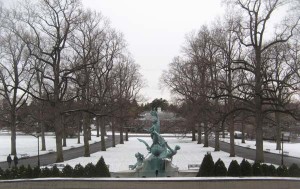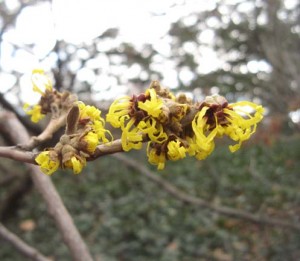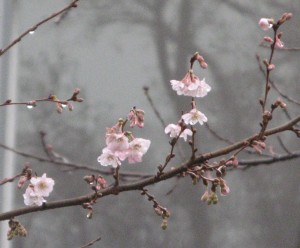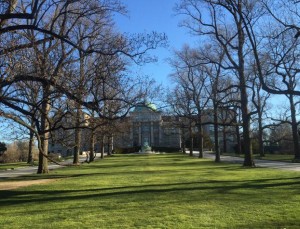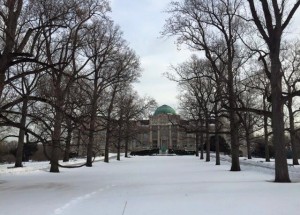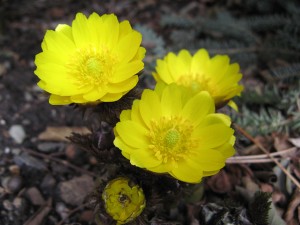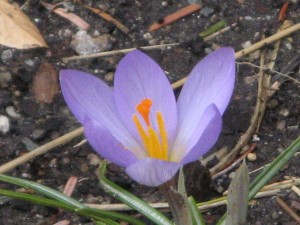Snowdrops – Galanthus – a winter “bulb” in bloom at NYBG
Witch Hazel – Hamamelis sp. – NYBG
Here’s the flowering cherry - Prunus x subhirtella “Autumnalis Rosea”……It’s a hybrid AND a cultivar – the only one I know that regularly flowers in December & January…..
Two photos of the NYBG 5 days apart – January 21 and 26 [The double row of trees are Tulip-poplar trees]
Adonis coming into bloom at NYBG February 2, 2016
WELCOME TO POP – the NYBG Introduction to Plant Science Course – Winter, 2016
First CROCUS of 2016 seen on February 7th in Inwood Hill Park !!!
————————————————————————————————————————————————-
PLANTS ARE LIVING ORGANISMS THAT MAKE THEIR OWN FOOD – AND FEED THE REST OF US ON THE SURFACE OF THE EARTH. We CANNOT exist without plants. We’re here to learn about what they are, how they grow, where they grow, what they do, how they reproduce, how they communicate, how they heal themselves, and how they defend themselves against everything that wants to eat or destroy them…..
————————————————————————————————————————————————-
January 30, 1854: “The winter, cold and bound out as it is, is thrown to us like a bone to a famishing dog, and we are expected to get the marrow out of it. While the milkman in the outskirts is milking so many scores of cows before sunrise these winter mornings, it is our task to milk the winter itself. It is true it is like a cow that is dry, and our fingers are numb, and there is none to wake us up. Some desert the field and go into winter quarters in the city. They attend the oratorios, while the only music that we countrymen hear is the squeaking of the snow under our boots. But the winter was not given to us for no purpose. We must thaw its cold with our genialness. We are tasked to find out and appreciate all the nutriment it yields. If it is a cold and hard season, its fruit, no doubt, is the more concentrated and nutty. It took the cold and bleakness of November to ripen the walnut, but the human brain is the kernel which the winter itself matures. Not till then does its shell come off. The seasons were not made in vain. Because the fruits of the earth are already ripe, we are not to suppose that there is no fruit left for winter to ripen. It is for man the seasons and all their fruits exist. The winter was made to concentrate and harden and mature the kernel of his brain, to give tone and firmness and consistency to his thought. Then is the great harvest of the year, the harvest of thought. All previous harvests are stubble to this, mere fodder and green crop. Now we burn with a purer flame like the stars; our oil is winter-strained. We are islanded in Atlantic and Pacific and Indian Oceans of thought, Bermudas, or Friendly or Spice Islands.” Henry David Thoreau
——————————————————————————————————————
We will discuss the following topics in class…………read this material and then read it again……….
MYCORRHIZAE……All plants have root connections with FUNGI- [These fungi are microscopic filaments that attach to the root ends of plants and live live symbiotically with them.] These fungi extend out many times the length of the plant roots, and they can bring into the plant the needed nutrients like nitrogen and carbon and phosphorus and potassium, that the plant needs to live and grow. [In exchange, the fungi get sugars that the plants make in their leaves and store in their roots.]
MAD-cap- Horse…………The native WOODY plants with OPPOSITE branching – M for Maple, A for Ash, D for Dogwood, Cap for Viburnum, and Horse for Horsechestnut and Buckeye…..
Shortest day of the year – December 21 (Winter Solstice)…..Longest day of the year – June 21 (Summer Solstice)…..Equal day and night: Spring Equinox (March 21) and Fall Equinox (Sept. 21)…………………..longest day: 15 hours of daylight……shortest day: 9 hours of daylight……equal day/night: 12 hours of daylight
XYLEM is the name of the WATER-conducting tube that run the length of the plant – from the root to the top. Xylem is found in the center of the root, but in the above ground parts of the plant it is found just inside the outer skin of the plant.
PHLOEM is the name of the FOOD-conducting tube that runs the length of the plant – from the root to the top. It is straw-like. Food in the form of sugars move through the phloem to reach places in the plant where energy is needed, such as the buds. Phloem travels downward into the roots where it is the stored food of the plant.
The plant CELL is composed of a number of essential parts: (1) the cell wall, which is made of cellulose, (2) the membrane just inside the cell wall that protects the cell from predators, (3) cytoplasm, which is the gel-like substance inside the cell, (4) the nucleus, which is the “command center” of the cell, (5) chloroplasts, which is where photosynthesis takes place, (6) mitochondria, which is where the plant digests the food (sugars) it makes and turns it into energy, (7) ribosomes, which make the proteins essential for cell growth, (8) the vacuole, which is a place in the cell where waste products and excess water can be stored.
PHOTOSYNTHESIS is the name of the process by which light energy from the sun is converted into chemical energy that fuels the plant (and everything that eats plants, like us). WATER from the ground is brought into the plant through its roots, and this combines with CARBON DIOXIDE from the air. These two compounds in the presence of sunlight and chlorophyll are transformed into sugar and oxygen. Chlorophyll is a pigment made in the plants’s chloroplasts, where photosynthesis takes place. The sugars that the plant makes in its chloroplasts are converted into energy in the cell’s mitochondria. Tbe Xylem brings water into the plant cell and Phloem moves the food (in the form of energy) where it is needed for the plant to make more of itself (to grow), as well as to flower and fruit and store food for the following year.
POLLINATION is the name of the method by which FLOWERS get the pollen they need to be fertilized, that is, to make seeds. Pollination can be by WIND or ANIMALS. If you can SEE the flower, if it is pretty or large or somehow noticeable the flower is most likely ANIMAL pollinated. Examples of ANIMAL pollinated flowers include roses, cherries, sunflowers, orchids. If you cannot SEE the flower, or if it is inconspicuous and doesn’t have PETALS, it is most likely WIND pollinated. Examples of WIND pollinated flowers include oaks, birches, maples, grasses. There are ANIMAL and WIND pollinated flowers in both MONOCOTS and DICOTS.
DISPERSAL is the term we use to describe how FRUIT leaves the plant. Fruit dispersal can be by ANIMAL or WIND. Examples of ANIMAL DISPERSAL include acorns, cherries, apples, all juicy fruits and nuts. Examples of WIND DISPERSAL include maple seeds, birch seeds, grass seeds, dandelion seeds.
We say that an APPLE TREE is ANIMAL POLLINATED and ANIMAL DISPERSED. An OAK TREE is WIND POLLINATED and ANIMAL DISPERSED. A MAPLE TREE is WIND POLLINATED and WIND DISPERSED. A DANDELION is ANIMAL POLLINATED and WIND DISPERSED.
A plant’s SEED contains 2 essential components, in addition to the SEED COVERING. The EMBRYO is the result of fertilization. The embryo is the plant’s “baby.” The COTYLEDONS, which are inside the seed, are the food reserve for the over-wintering embryo, and the first part of the new plant to break ground in the spring. MONOCOTS, like grasses, have a single cotyledon. DICOTS have 2 cotyledons. These food reserves help the developing plant get started in life. Once they break ground and start to photosynthesize and make energy for the plant, they die and the growing plant takes over.
CARNIVOROUS PLANTS are those plants that can grow in soils that are especially deficient in nitrogen, like bogs and swamps. Carnivorous plants make special leaves that TRAP insects, and they decompose their bodies to make use of the nitrogen compounds they contain. VENUS FLY-TRAP is one kind of carnivorous plant. PITCHER PLANTS are another example.
PARASITIC PLANTS are those plants that either LACK CHLOROPHYLL and must take all their NUTRITION from other plants, or they contain chlorophyll but need some of their nutrients from other plants. DODDER is an example of a plant that is completely parasitic on other plants. MISTLETOE is an example of a plant that is partially parasitic on other plants.
Most plants contain BOTH MALE and FEMALE flowers on the SAME PLANT. Sometimes the male (STAMENS) and female (PISTIL) occur in the SAME FLOWER, which is the case with all the plants in the ROSE FAMILY. Mostly, though, MALE and FEMALE flowers occur on the SAME PLANT but in DIFFERENT PLACES, which is the case in the OAK TREE or the BIRCH TREE. In some cases the MALE and FEMALE FLOWERS occur on DIFFERENT PLANTS – which is the case with the GINKGO and the HOLLY.
HORMONES………These are the compounds that mediate (make possible) the various activities of the plant. One hormone (AUXIN) helps the plant grow tall. It also moves the plant towards the light. Another hormone (ETHYLENE) ripens fruits. It also is the hormone responsible for leaf drop in the fall. There are other plant hormones but these are two of the most important ones.
NITROGEN is essential for all plants and animals. Plants get nitrogen through the soil, dissolved in water. The BEAN FAMILY is the most important plant family on the planet because it can FIX nitrogen in the soil – and make into a usable compound that all plants and animals can use. The BEAN FAMILY has NODULES on its roots, tiny enclosures that soil bacteria come into and these bacteria are responsible for “nitrogen fixation.” As BEAN FAMILY plants grow and decay, the nitrogen in their tissues goes into the ground – and then into other plants (and the animals that eat them).
Name 3 things ROOTS do for plants: anchor, bring in water & nutrients, and store food.
Name 4 things WATER does inside plants: bring in essential nutrients, hydrate, cool and cleanse plants, and provide an essential compound for photosynthesis.
What is photosynthesis: A process by which water (from the ground) and carbon dioxide in the air, in the presence of sunlight and chlorophyll (made in the leaves) can produce utilizable food (a sugar) as well as oxygen (a waste product in this particular reaction).
Name 4 major groups of plants in the Plant Kingdom: Mosses, Ferns, Conifers, and Flowering Plants.
Name two groups of spore-bearing plants: mosses and ferns.
Name two groups of seed-bearing plants: conifers and flowering plants.
How many species of each group are known to be around today: Mosses (15,000), Ferns (15,000), Conifers (700) and Flowering Plants (300,000).
Classification of Plants: Kingdom, Phylum, Class, Order, Family, Genus and Species…..
KINGDOM: The Plant Kingdom
PHYLUM: There are 4 Phyla of Plants: Mosses, Ferns, Conifers, and Flowering Plants. [Phylum (singular) and Phyla (plural) = "groups" of plants]
CLASS: Within each Phylum of plants there are major subdivisions, called Classes.
Flowering Plants are composed of 2 major Classes: the MONOCOTS and the DICOTS.
The MONOCOTS include the grasses, the lilies, the orchids, the palms, and a few other groups. There are 80,000 species of Monocots.
The DICOTS include ALL woody plants, plus all non-woody plants that are NOT Monocots. There are 220,000 species of Dicots.
MONOCOTS can be recognized by particular features: the leaves have parallel veins. The flowers, if they have petals, have 3 or 6.
DICOTS can be recognized by particular features: the leaves have a mid-rib and side veins. The flowers, if they have petals, have 4 or 5.
There are exceptions to the above. For example, Skunk Cabbage is a Monocot but it has leaves that have a mid-rib and side veins.
PLANT FAMILIES: There are about 500 Families of Flowering Plants. The 500 Families contain a total of nearly 300,000 species.
Plant Families are recognized by two principal features: what they look like (their morphology) and what they contain (the compounds the make against predators).
Plant Family NAMES all end in the letters “-ceae.” For example, the Rose Family is Rosaceae. The Family oaks are in is called the Fagaceae.
A Plant Family can contain one or more genera (singular: genus). The Rose Family contains many genera.
Rose Family genera: rose (Rosa), strawberry (Fragaria), blackberry and raspberry (Rubus), cherry and plum (Prunus), apple (Malus), etc.
A GENUS (plural GENERA) can contain one or more species: Quercus is the genus of the oaks. Quercus alba is the white oak. Quercus rubra is the red oak. Quercus palustris is the pin oak. Etc.
A SPECIES NAME is ALWAYS composed of two parts: a genus and a species epithet. The white oak is NOT simply “alba” – it is Quercus alba.
Below the level of species there are varieties, hybrids and cultivars.
Prunus x subhirtella is a HYBRID flowering cherry composed of parents from two different species of cherry, one of which is listed after the “x” symbol: subhirtella.
Prunus x subhirtella “Aurumnalis Rosea” is a CULTIVAR. When grown out in a great number, the hybrid cherry produces variation in its flowers or leaves. One such variation is what we call the Autumn Flowering Cherry, Prunus x subhirtella “Autumnalis Rosea” – It is not grown from seed, but from a cutting. It is a clone.
Plant Families can be recognized by two principal features: what they look like (their morphology) and what they contain (their “secondary metabolites” or what they make to deter predators).
The Rose Family (Rosaceae) has flowers that are called “perfect” because they contain petals, stamens and at least one pistil. All Rose Family plants contain 5 petals (as well as 5 sepals – the outer green leaves that enclose the petals) plus many stamens (5 or more stamens) plus at least one pistil. Members of the Rose Family produce Prussic Acid in their tissues, which converts to cyanide on ingestion. This makes the fresh leaves of cherries, for example, or the seeds of apples, if eaten in quantity, poisonous. These two features help differentiate this family from all other plant families.
The Nightshade Family (Solanaceae), which we know as the family of potatoes and tomatoes and eggplant and bell peppers, as well as tobacco and deadly nightshade, contains some plants that produce berries resembling cherries, except that these berries contain multiple seeds, like tomatoes, not a single seed, like a cherry. The Nightshade Family has flowers very different from the flowers of the Rose Family, and the Nightshade Family produces toxins in a class of compounds called alkaloids. These are what make potato plants and potato sprouts poisonous. Some nightshades contains more of these compounds than other plants in this family, and can be quite deadly if ingested. Deadly nightshade is both a deadly poisonous plant and a valuable medicinal drug – eye doctors use an extract of Belladonna (Deadly Nightshade) to dilate pupils to look for eye disease.
Most of our staple foods are Monocots: wheat, rice, corn, barley, and oats.
Some dicot staple foods include beans and, in tropical rainforests, where grains can’t be grown, manioc (tapioca).
Our principal fruits are Dicots: our berry plants, grapes, oranges & lemons, melons, tomatoes, and others.
FRUIT: the cherry is called a DRUPE. A blackberry is composed of multiple drupes, called drupelets. An apple is called a POME. True berries typically have many seeds scattered throughout the interior of the fruit: Blueberry is an example of a “true” berry; so is the tomato.
Monocot fruits that we use include coconuts and dates, both from palm trees, and bananas and pineapple.
POLLINATION: There are 2 basic forms of pollination: WIND and ANIMALS. [Animals include insects, birds, etc.]
The closer to the tropics the more the plants are ANIMAL pollinated; the further north or south of the tropics, the more the plants are WIND pollinated.
Our native forest plants are primarily WIND pollinated. Most of the plants we introduce because of the beauty of their flowers are ANIMAL pollinated.
————————————————————————————–
To WATCH the VIDEO of THE BOTANY OF DESIRE (By Michael Pollan) – - - http://video.pbs.org/video/1283872815/
To WATCH the VIDEO “DIRT: THE MOVIE” online……….http://www.hulu.com/watch/191666
https://www.youtube.com/watch?v=lFg21x2sj-M&feature=youtu.be…………..SEE this if you can – about leaf-cutter ants
READ THIS ARTICLE: http://www.newyorker.com/magazine/2013/12/23/the-intelligent-plant
—————————————————————————————-
WEEDS
Weeds are plants that grow where people don’t want them.
Weeds are plants that are invasive and sometimes they harm other plants.
Weeds can be TREES or SHRUBS or VINES or HERBACEOUS PLANTS .
WEED TREES include Black Cherry, Black Locust, Norway Maple, Ailanthus, Aralia, and others.
WEED SHRUBS include Wild Rose, Blackberry, Barberry, and anything that grows “out of control.”
WEED VINES include Honeysuckle, Bittersweet, Porcelain-berry, Poison-ivy, and more.
WEED HERBACEOUS PLANTS include Dandelion, Garlic-mustard, Wild Onion, Shepherd’s Purse, Burdock, and lots more…..
Most HERBACEOUS WEEDS are Annuals, plants that come up, leaf out, flower, fruit, and die.
BIENNIAL WEEDS are Herbaceous Plants that come up and become leafy the first year, then overwinter as ground leaves, and grow up, flower then fruit and die the SECOND year. Burdock is a biennial weed.
ROOTS: Weed roots can be tap-roots, like Dandelion. These usually grow originally from seed.
Roots can also be RHIZOMES, that is, an underground horizontal root that expands underground and out of which plants rise up at various spots. Japanese Knotweed is an example of a plant with a Rhizome.
Some Weedy plants have Horizontal Roots that grow over the ground rather than underground, and drop rootlets down into the ground every so many inches. These are known as STOLONS. Wild Strawberry and Glechoma hederacea (Creeping Charley) are examples of plants that are Stolons.
Most HERBACEOUS WEEDS have a season in which they appear, usually spring. Some re-appear in the fall as the weather gets cooler. Some appear year-round, like Dandelion.
HERBACEOUS WEEDS are typically HELIOPHILES, a word that means that they are SUN-LOVERS. You don’t find them in deep woods or heavily shaded areas. They are weeds of our LAWNS and PATHSIDES in our urban and suburban areas.
HERBACEOUS WEEDS are also plants of DISTURBED AREAS, places where we have dug up the ground, left areas vacant, like vacant lots.
HERBACEOUS WEEDS of Lawns are those plants that you can walk on and not kill. These include CLOVER and DANDELION and PLANTAIN and WILD ONION.
PATH SIDE WEEDS include Shepherd’s Purse, Dock, Chickweed, Mugwort, and various Mints.
HERBACEOUS WEEDS can be either MONOCOTS, like grasses, or DICOTS, like Dandelions.
The WORST WEED in our area is GARLIC-MUSTARD. It grows along roadsides and its roots “strangle” nearby tree roots, preventing the trees from absorbing water and nutrients. Then, when the trees die, the GARLIC-MUSTARD plants move into where the trees, now dead, are standing, and GARLIC-MUSTARD continues to move into our local woods one tree at a time. After only a few years, you can find GARLIC-MUSTARD many yards from the roadside, as they continue to move into a woodland.
GARLIC-MUSTARD produces a lot of seeds. One plant can produce 1000 seeds. If there are 100 plants growing in an area, that’s a lot of seeds that can germinate and produce more plants. NOT ALL THE SEEDS GERMINATE AT THE SAME TIME. Some seeds germinate the first year, some the second year, some later. This means that WEEDING of GARLIC-MUSTARD can take many years to completely eradicate it from an area.
While GARLIC-MUSTARD is a weed of mostly dry areas, there is a weed of WET AREAS that can be just as damaging. It’s called LESSER CELANDINE. It grows in areas where there is surface water, near streams, for example, but also where there is no apparent water. In areas where there are streams or bodies of water, LESSER CELANDINE can take off – and cover the ground so thoroughly that no other herbaceous plants, like wildflowers, have room to grow. Once it gets into an area, the only way to get rid of it is to shovel it out, and replant the area with plants you want.
There’s more to learn about weeds than there is time to cover in a short course about them. It’s up to you to make time to learn about them. If you GARDEN and you don’t WEED, you’ll discover that all you’ll be growing are WEEDS. If you plant trees or shrubs and you don’t use WOOD MULCH as a ground cover around your newly planted trees and shrubs, you’ll discover that the WEEDS will come in and compete with your plantings for the available water and nutrients. Wood Mulch suppresses weed growth, as well as keeps the ground from drying out too quickly.
For examples of HERBACEOUS WEEDS, go on this Website to the page titled “Welcome to Joy of Foraging” and scroll down the page. There are lots of photos of our common weeds, many of which are EDIBLE !!!


